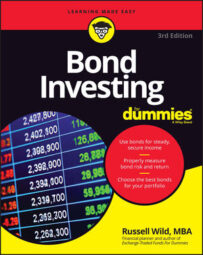A bond, no matter its quality or maturity, tends to rise and fall in value with the general conditions of the markets and of the economy. Prevailing interest rates, the rate of inflation, and supply and demand all affect a bond’s value.
It’s like your home; no matter how well you maintain it or whether you renovate the kitchen, tends to rise or fall in value along with the value of all other houses in your neighborhood. Many things outside of your control — the quality of the schools, employment opportunities, crime rates, and earthquake tremors — can greatly influence the value of homes in your area, including yours.
Prevailing interest rates
Nothing affects the value of bonds (at least in the short to intermediate run) like prevailing interest rates. When interest rates go up, bond prices go down, usually in lockstep. When interest rates fall, bond prices climb.
The relationship is straightforward and logical enough. If you’re holding a bond paying yesterday’s interest rate, and today’s interest rate is lower, then you are holding something that is going to be in hot demand, and people will pay you dearly for it. If you’re holding a bond paying yesterday’s interest rate, and today’s rate is higher, then you are holding mud.
Okay, that part is simple. Interest rates drive bond prices. But what drives interest rates?
Interest rates come in many different flavors. At any point in time, there are prevailing interest rates for home mortgages, credit card payments, bank loans, short-term bonds, and long-term bonds, but to a great extent they all move up and down together. The forces that drive interest rates are numerous, entwined, and largely unpredictable (even though many people claim they can predict).
In the short run — from hour to hour, day to day — the Federal Reserve, which controls monetary policy in the United States, has great power to manipulate interest rates across the board. The Federal Reserve’s job is to help smooth the economy by tinkering with interest rates to help curb inflation and boost growth.
Low interest rates make borrowing easy, both for businesses and consumers. That helps to heat up the economy, but it can also result in inflation. High interest rates discourage borrowing and so tend to slow economic growth, but they also help to rein in inflation. So when inflation is running too high, in the eyes of the Fed, it moves to raise interest rates.
And when the economy is growing too slowly, the Fed tends to lower interest rates. Obviously, it’s a balancing act, and perfect balance is hard to achieve.
In the longer run — month to month, year to year — interest rates tend to rise and fall with inflation and with the anticipated rate of future inflation.
Know this: Rising interest rates are, in the short run, a bondholder’s worst enemy. The possibility that interest rates will rise — and bond prices will therefore fall — is what makes long-term bonds somewhat risky. If you wish to avoid the risk of price volatility, go with short-term bonds, but be willing to accept less cash flow from your bond holdings.
The rate of inflation
The inflation rate signals the degree to which you have to cough up more money to buy the same basket of goods; it indicates your loss of purchasing power. In the long run, the inflation rate has great bearing on returns enjoyed by bondholders. The ties between the inflation rate and the bond market are numerous.
In economic theory, bondholders are rational beings with rational desires and motivations. (In reality, individual investors often act irrationally, but as a group, the markets seem to work rather rationally.) A rational buyer of bonds demands a certain inflation-risk premium. That is, the higher the rate of inflation or the expected rate of inflation, the higher an interest rate bondholders demand.
If inflation is running at 3 percent, which it has, more or less, for the past several years, bond buyers know that they need returns of at least 3 percent just to break even. If the inflation rate jumps to 6 percent, the inflation-risk premium doubles; bond buyers won’t invest their money (or won’t invest it happily) unless they get double what they were getting before.
Inflation is also a pretty good indicator of how hot the economy is. When prices are rising, it usually reflects full employment and companies expanding. When companies are expanding, they need capital. The need for capital raises the demand for borrowing. An increased demand for borrowing raises prevailing interest rates, which lowers the price of bonds.
Know this: As a bondholder, you can get stung by inflation. Badly. That’s why I recommend that a certain portion of your bonds (around one-quarter, or more if you are shunning stocks) be held in inflation-adjusted bonds, such as Treasury Inflation-Protected Securities (TIPS). It’s also why a 100-percent bond portfolio rarely, if ever, makes sense.
Stocks have a much better track record at keeping ahead of inflation. Real estate and commodities can do a pretty good job, too.
Forces of supply and demand
The public is fickle, and that fickleness is perhaps nowhere better seen than in the stock market. Although the bond market tends to be less affected by the public’s whims, it does happen. At times, the public feels pessimistic, and when the public feels pessimistic, it usually favors the stability of government bonds.
When the public is feeling optimistic, it tends to favor the higher return potential of corporate bonds. When the public feels that taxes are going to rise, it tends to favor tax-free municipal bonds. As in any other market — shoes, automobiles, lettuce — high consumer demand can raise prices, and low demand tends to lower prices.

